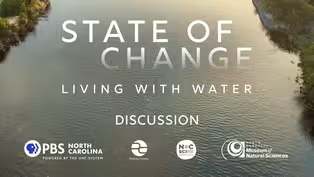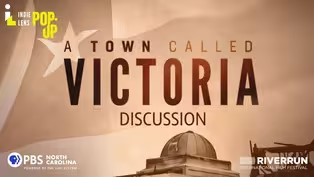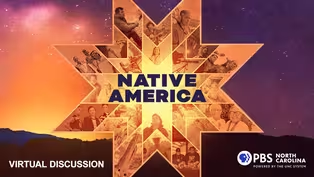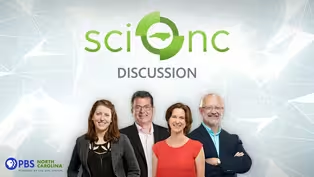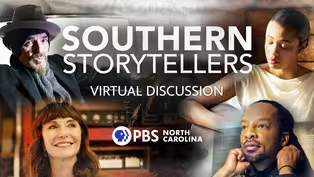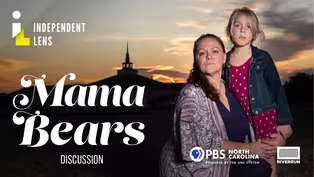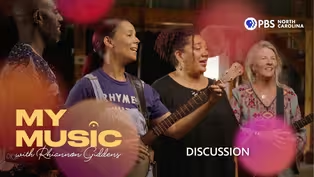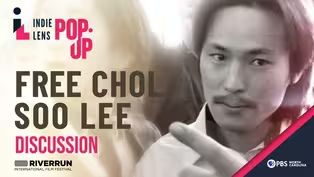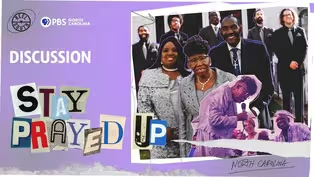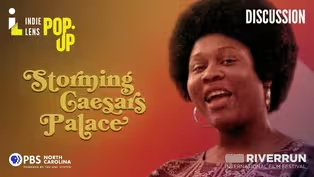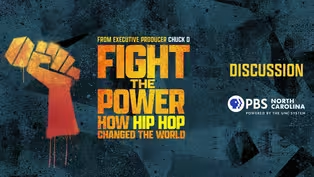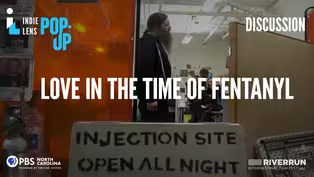PBS North Carolina Specials
Discussion | Independent Lens: Move Me
11/3/2022 | 38m 46sVideo has Closed Captions
A dancer with blindness and disability advocates discuss adaptable arts programs.
Shannon Vickery, PBS NC's director of corporate engagement, leads a conversation about adaptable arts programs and access. Our panelists: Davian "DJ" Robinson, founder of Empower23, Eileen Bagnall, executive director of ArtsAccess, Inc. and Sarah Wilbur, MFA,Ph.D, professor of dance studies and researcher at Duke University. The conversation was translated by ASL interpreters.
Problems playing video? | Closed Captioning Feedback
Problems playing video? | Closed Captioning Feedback
PBS North Carolina Specials is a local public television program presented by PBS NC
PBS North Carolina Specials
Discussion | Independent Lens: Move Me
11/3/2022 | 38m 46sVideo has Closed Captions
Shannon Vickery, PBS NC's director of corporate engagement, leads a conversation about adaptable arts programs and access. Our panelists: Davian "DJ" Robinson, founder of Empower23, Eileen Bagnall, executive director of ArtsAccess, Inc. and Sarah Wilbur, MFA,Ph.D, professor of dance studies and researcher at Duke University. The conversation was translated by ASL interpreters.
Problems playing video? | Closed Captioning Feedback
How to Watch PBS North Carolina Specials
PBS North Carolina Specials is available to stream on pbs.org and the free PBS App, available on iPhone, Apple TV, Android TV, Android smartphones, Amazon Fire TV, Amazon Fire Tablet, Roku, Samsung Smart TV, and Vizio.
Providing Support for PBS.org
Learn Moreabout PBS online sponsorshipMore from This Collection
Discussion - State of Change: Living with Water
Video has Closed Captions
Panelists discuss resilient North Carolinians adapting to climate change. (28m 54s)
Discussion - A Town Called Victoria - Independent Lens
Video has Closed Captions
The filmmaker and former Victoria residents share their story. (46m 51s)
Discussion - Native America Season 2
Video has Closed Captions
Panelists discuss preserving the languages of Native American tribes. (39m 1s)
Video has Closed Captions
Sci NC executive producer and host, Frank Graff, chats about upcoming Season 6 of Sci NC. (26m 6s)
Discussion - Southern Storytellers
Video has Closed Captions
Author David Joy and others discuss storytelling and their new PBS series. (42m 13s)
Discussion - Mama Bears | Independent Lens
Video has Closed Captions
Producer and director Daresha Kyi discusses the film and LGBTQIA+ advocacy. (34m 41s)
Discussion - My Music with Rhiannon Giddens
Video has Closed Captions
Discussing the series with producers Will & Deni McIntyre and country artist Rissi Palmer. (39m 56s)
Discussion - Free Chol Soo Lee | Independent Lens
Video has Closed Captions
Local lawyers, professors and nonprofit leaders discuss wrongful convictions and reentry. (40m 44s)
Discussion - Stay Prayed Up, Reel South
Video has Closed Captions
The filmmakers discuss their journey with Mother Perry and The Branchettes. (45m 4s)
Discussion - Storming Caesars Palace | Independent Lens
Video has Closed Captions
Local professors and nonprofit leaders discuss welfare and the social safety net. (33m 2s)
Discussion - Fight the Power: How Hip Hop Changed the World
Video has Closed Captions
Local experts discuss the history of hip hop with PBS North Carolina. (59m 43s)
Discussion - Love in the Time of Fentanyl | Independent Lens
Video has Closed Captions
Local harm reductionists, therapists and others discuss the opioid crisis and more. (55m 44s)
Providing Support for PBS.org
Learn Moreabout PBS online sponsorship- [Shannon] Good evening everyone.
I'm Shannon Vickory, Director of Corporate Engagement here at PBS North Carolina.
Thank you so much for joining us.
We are proud to bring the Independent Lens pop-up film series to you, starting with "Move Me."
We are here to discuss a very important topic: accessibility and adaptability of arts and arts programs for people with varying degrees of abilities.
We wanna provide a safe space for an open and informative community-driven discussion.
Please be respectful as you enter your questions and comments for this evening's panelists in the chat feature to the right of your screen.
There will also be a link to an audience survey in the chat, and your comments about the film and this event are greatly appreciated.
I wanna thank ASL interpreters Karen Magoon and Christina Whitehouse-Suchs for interpreting this evening's discussion.
Now, without further ado, we have three very special guests that I'd like to introduce to you.
Here with us tonight are Davian "DJ" Robinson, founder of Empower 23 and featured on an episode of PBS North Carolina's, "My Home NC."
Eileen Bagnall, executive director of Arts Access Inc. And Dr. Sarah Wilbur, an associate professor of the Practice of Dance and Theater Studies and a researcher at Duke University.
Thank you all for joining us this evening for this discussion.
And DJ, let's start with you.
Tell us about your experience with dance.
What barriers, if any, did you face at the university level in your dance classes?
With the Americans with Disabilities Act, colleges need to provide accommodations.
So describe that process to us and specifically your movement mentor.
- Yes, so, I'm DJ Robinson and thanks for having me.
And I have currently been doing work around access that has led me to do works recently with ShaLeigh Dance Works and doing a world premiere called "enVISION: Sensory Beyond Sight" that helps to shed light on and also promote the stories and shed light to the existence of persons with blindness.
But also it's more of a humanitarian thing around disability as a whole to help bring the audience into a space that people like myself go through on a regular basis.
But also just to raise awareness and empathy and understanding about the community of blindness, but also more of a holistic standpoint in that regards.
And as far as my dance experience goes, I've danced since I was 12.
I first started at the University of North Carolina at Charlotte back in 2016.
I graduated from there in 2020 with my BA in Dance Performance, Choreography Theory and Exercise Science.
And along that journey, I just in brief, was tasked with entering a dance class as a minor.
And my mentor at the time, Karen Hubbard, she had let me come into class for the first time and she saw that I was the first blind student she had ever had.
She had seen other persons with disabilities enter into dance, but just not someone with my level of vision at the time.
And she never said no, she never said, "We can't make this accommodation."
She just said, "How?"
And so she partnered with me along with the services at USC Charlotte and the dance department to help make this accessible for me.
So we came up with the dance mentor.
And the dance mentor was someone who is also someone who is skilled in particular dance formats, whether it's ballet, tap, modern, contemporary, the like, and they would come in and give me one-on-one coaching and hands-on negotiation in space and allowing me to get a more visual understanding of what the instructors or professor wanted in individual dance classes.
They would provide me with that kinesthetic hands-on learning in which I learn.
And it's pretty much a relationship that's built on trust, respect, and communication.
And those are the fundamental things that help someone like myself go into a dance class and feel that I can grow in my art and my artistry.
And the biggest thing that I noticed throughout the process was that there was a lack of education, a lack of resources and a lack of preparation throughout and whether it was the failure of an institution to provide the resources or myself or just collectively as a whole.
But as I ventured through the program, I was able to develop practical principles and strategies around how to communicate with professors, how to communicate with my mentor, and how we can communicate as a whole to provide a place that is accommodating structurally and from an artistic standpoint to help me flourish as a dancer and a mover.
So, yeah.
- Well DJ, thank you so much for sharing your art with us this evening and being a part of this discussion.
Sarah, I wanna turn to you and talk a little bit about your research.
For the research that you have conducted at Duke, can you talk about whether dance heals, and explain the different context in which people talk about dance being healing and a healing process?
- Thanks Shannon and hi everyone, I'm Sarah and I'm so happy to be here and so thankful to be with DJ and Eileen and to learn with folks.
I am a white, brown-haired, able-bodied woman sitting at a desk here talking to Shannon about this important question.
And I guess my first comment is that I take to heart what DJ's talking about here in terms of the constant labor of education and learning that has to go on for people who work in institutions of higher education to accommodate persons that live with all kinds of embodiments.
So we could talk about disabilities, but I think I'm really struck, DJ, by your pointing to the labor that's often thrust upon persons who live with disabilities to educate persons that do not currently live with disabilities to accommodate their learning.
So I am as much a student of this practice and someone who's constantly trying to pattern my own practices in a way that doesn't create unnecessary labor for artists in the world.
'Cause DJ's an amazing artist and you all should just check out "Sensory Beyond Sight."
So, I'm a fan.
I also wanna hear from Eileen on this.
Okay, so, back to the question, does dance heal?
Oh my gosh.
So, this is like the easiest question and the hardest question to answer at the same time.
So, I could say it this way, I'm a dancer and I love dance, so just get that straight.
Like, I love to dance and I think anyone on this call, I would dare you to disagree.
If someone tells you that dance heals them, they're correct, full stop.
People dance and dancing can produce healing, sense of therapeutic benefits.
And I'm not a medical researcher or a clinician.
I write about how hard it is to be an artist in the United States, in terms of career.
And I think when we get into this question of healing, I think it is important to think about context because I think if we talk about like personally someone who's dancing like me as a young person to a Donna Summer albums in my bedroom at age seven in Milwaukee, Wisconsin, spinning around and sweating and getting her life, you know, I could say that that answer is an incontrovertible yes.
Dancing in clubs, teen clubs in the nineties, bring on, you know, my voguing and all my things and I got my life, yes.
Culturally speaking, in ritual contexts, in certain cultures, dancing, often music and dancing, has developed over time, centuries, as a means of healing trauma of all kinds.
I mean, whether it's colonial occupation or settler colonial dispossession, indigenous folks in the United States.
The idea that dance brings good medicine is an indigenous principle that we can look to.
So here's where I'm getting to the why it's a hard question.
So we have to think about all these things, and then we have this thing called the health institutions in the United States, therapy, right?
Dance movement therapy, which is an institutionalized practice where dance artists receive psychological credentialing and credentialing in therapeutic and behavioral psychology to use dance as a method to produce therapeutic outcomes in a clinical sense, right?
So there's all these ways that I think dance can and tries to kind of universally heal.
But here's the thing, when Kelsey says, in the intro to this film, prior to her accident, dancing was this practice that was central to like her sense of wholeness.
That echoes for me my own experience and the experience of many of the students and folks that I study and work with in dance.
So I think dedicated dancers really probably agree upon this.
They return to dancing because it's doing something for them that people maybe can't see, but it's really stirring them, you know, inside.
But then there's this idea of making this film after an accident and living with a disability and then returning to dance was this unexpectedly therapeutic experience.
And to me, that's the wrinkle because institutionalized dance, what DJ's talking about, has its own hierarchies of embodiment, right?
So certain kinds of bodies are perceived as ideal in dance.
So dance does heal all kinds of people.
But if we're talking about what it means to be recognized as an artist or a dance artist in at least let's say in the United States, there are real norms of perception around beauty, what your body can do, even the idea of watching a dance with your eyes.
So DJ's performances are asking us to embody our experience in dance in all kinds of auditory and tactile and sensorial ways that really push back against dance's own, I don't wanna say wounding properties, but there are hierarchies that are not inclusive internal to the dance world.
So I'm really giving you a long answer because I think Kelsey's really inspiring me to think like at the center of my own experience, dance can make change happen for the better.
And this representation of dance is a beautiful change agent I think that Kelsey's giving us, but, dot dot dot, institutions have a long way to go, right?
So I would love to hear DJ's vibe on this because I'm a big fan.
Because I think it's like, people are gonna dance no matter what, but whether institutions are going to recognize and make legible certain kinds of dance is still up for grabs, I would say, in the United States.
What do you say DJ?
I'm sorry Shannon, I'm dying to know.
- Yes, what I would say to that is that while it's proved divinant during the last two years of course.
As I dance, I've seen dance evolve and shift in what's ideal, what's acceptable, what's the status quo.
But then I've also seen with my time at Duke while I was there for a while, how you can break down the notions of an institutionalized way of movement and an institutionalized way of expression that is lending, that is giving itself to a hierarchical way of doing and being and seeing it.
But what I also realize is that if you can not only educate, but if you can find the language that is inclusive and that is not exclusive, that in itself will help to change the dynamic and change the atmosphere in how institutionalized dance is looked at and made accessible.
But at the same time, if you look at how Covid over the last two years has caused us, and I wanted to bring this up, caused us to come together in this Zoom platform, it's brought more people together than ever.
And whether it has been through Black Lives Matter or disabilities, whatever the case may be, LGBTQ, it's brought all of these dynamic different people, bodies and ideals and backgrounds together and expressed in a way where it wasn't before.
It's a beautiful thing that Covid allowed us to find a inner inner healing aspect that wasn't there before, like a moment of acceptance that, "Hey, I can be in this Zoom space, I can be in the comfort of my home or outside, and still be a part of the collective.
And the institutionalized thing that said I had to be this way isn't over me, but I can be in the comfort of these other environments and thrive.
And then how can I take those?
It's the question then, how can you take those learned experiences outside of the institutionalized way and bring it back into it with a fresh perspective.
- Oh, that's, Eileen, I wanna bring you into this fascinating conversation because at the heart of tonight's film, you know, it was all about inclusion and adaptability and your organization is working here in North Carolina to make the arts inclusive and accessible to everyone.
So talk to us about how you do that and the work of Arts Access Inc. - All right, at Arts Access, our mission is to create a positive impact at the intersection of arts, education, and disability.
And so this is great to be talking about the university systems.
And how we work with schools is that we start with the top up and talk to principals and work through the schools so that when we come in to do an arts integration school residency for students, we have buy-in and everybody knows why we're there.
And we don't come in once.
Every spring, you know, we come in and do something.
We're there to work with the classrooms and with the teachers to create means of communication using art.
Because one of the things unfortunately in schools is there are so many other important things that students need, students with disabilities need to learn.
They may have physical therapy, occupational therapy, speech therapy, and they're pulled in and out of class.
And one of the things that gets dropped is art.
So by working with the school classroom teachers, the special ed specialists, and showing them that you can use art, whether it be in occupational therapy, because manipulating clay builds muscles in your hand that students will need to use for writing or working on a computer or anything like that, building up the fine motor skills.
So that's one of the ways we work in the way of art.
And in the community, the arts community, we work with arts organizations to make sure that they're not just compliant with the Americans with Disabilities Act, but they're excited about how they can create accessible programming.
We, again, we start from the whole organization.
We can work with their board, work with their staff, work with their docents and volunteers to make sure that they are welcoming to people with disabilities and they understand the what and where and how and why it's important.
When we do our trainings, we have a panel of disabled people who talk about their experiences at that organization or another similar one, about what it's like for them to go to the theater when they have vision loss and have audio description and how it brings the life of the play, the opera, whatever it is, into them.
We had a performance a couple weeks ago and the group that came, I got an email, and they were like, "They're bubbling over with joy," because for some of them, obviously, they hadn't been out in a while with Covid, but they finally got to experience a play with audio description, which is just like play-by-play in sports, that they were able to understand what was going on on stage and not just hear it and really become part of the whole audience experience.
And we're just committed to this because it is an incredible change for people to be able to communicate through art, express through art, or be a part of the ShaLeigh Dance Project.
That was amazing.
Our staff helped on that in terms of advising and working with them with audio descriptions so that dancers would understand the best way to describe their movement, because they weren't professional audio describers, so our team of audio describers did that.
So it's very collaborative, and we want everybody to have a chance to be part of the creative life in North Carolina because there's so many things going on.
- Indeed, indeed.
DJ, let's talk a little bit about the organization that you have founded, Empower 23, because you are now utilizing your artistry, your experiences, in creating this organization and creating your "Sensory Beyond Sight" dance workshop.
So tell tell us more about this work and your goals for it.
- Yeah, so this started out just as an idea my junior year of college, I actually, this was a service project that I had to do as I was a Gilman scholar, Benjamin E. scholar for study abroad.
And I went to Italy to study abroad for three weeks in Torino, Italy.
And it just came out of the idea I wanted to bring in an educational basis for this while also bringing in practical strategies and principles to inform sighted dancers so that they can not only just come into my own experience and the experience that others with vision impairments may have, but how they can step away from their own insecurities, comparisons and perfections and just embrace self-acceptance within their own bodies through the elimination of sight.
And as we move through the workshop that I was able to establish there, it's progressions in which it challenges them to tap into the sensoriums of the body and also locate blind spots within their own artistry and movement that they can identify and then go deeper and further into that movement.
And once you tap into the full sensoriums of the body, you're able to then have a full, rounded understanding of how you can become one with your environment and your environment can become a part of you.
And the idea of Empower 23 is that I help to educate sighted audiences, sighted dancers on the importance of empathy and understanding that needs to be had when you are a choreographer, an instructor, and also a dancer yourself in order to fully bring accessibility to the arts and in the classroom, in the studio, and regardless, because without a fundamental understanding of how others may exist and can exist in the space, then it's my belief that it's hard for you to create effective programs around accessibility and call them accessible if they're missing fundamental principles that are meant to help guide you and educate you.
Just like for me, I go by the terrible Ts, this, that, and there.
When you hear about "this, that, and there," what are these?
There is directional terminology.
And so people, you can look at it as lazy speech in a way.
When you say this and that and there, you limit what the person with the blindness like myself can fully understand.
Are you saying right stage is there?
Left stage is there?
Are you saying this ruler in your hand or this position of arabesque?
You know, it's, it's forcing you to turn that lazy speech into directional, clarified, accessible language in which all audience members, it doesn't have to be blindness particularly, but it could be addressed to all bodies, all disabilities alike.
And so the organization just meant towards that educational, fundamental foundation, so yeah.
- And Sarah, when you get to the heart of the question about accessibility in art, a lot of it comes down to funding.
So based on your research, you know, how are you counseling artists like DJ and others when it comes to finding those funding sources so that more people can get involved in programs like DJ's or actually get an opportunity to see a performance like Kelsey's that was featured in tonight's film?
- Yeah, it's such a great question.
I got so excited by your first question.
I didn't introduce myself properly, but I'm a dancer and choreographer and in my research, in my academic research, I write about economics and arts funding in the United States.
And when I say how hard it is to be an artist, I'm usually talking about the economic barriers to living a full and flourishing life in dance.
So to this question, I would answer it in two directions.
One is, you know, to artists looking for support, there's one kind of answer, but then to people who are themselves funders or wealth holders in dance, there's like another answer to this question, which is just to say that, you know, historically, I mean, even though the Americans with Disabilities Act happened a long time ago, funding bodies in the United States have been historically slow to embrace guidelines and grant structures that embrace an accessibility aesthetic, right?
So I'm using words here that are kind of central to disability arts activism.
People like Alice Shepherd are saying access itself is a form of reconfiguring beauty, right?
So when DJ's workshop asks participants who are sighted like me to put on a blindfold and be maneuvering through space and productively being disoriented to our habituated practice of seeing first and moving second, that is an artistic and aesthetic model that is to me, revolutionary.
And this is what artists do, of all stripes.
Artists ask us to pay attention differently.
So for funding bodies who care about dance and the arts and care about the future of living in a world where we don't dehumanize each other, frankly, like I would say to funders, let's start with an access aesthetic.
Like, can more funding bodies start from a wider definition of where dance happens, why it matters, and who is leading the conversation?
So that's my answer to folks who are holding the wealth.
The good news for artists that are centering disability activism in their work or are themselves artists with disabilities, there are funding bodies like Dance USA and I'm thinking of the Ford Foundation's individual artist grants that are making kind of a redistributive turn in their practices of funding artists to center artists engaging in social change, fellowship support to build peer cohorts of artists that are themselves coming together to create new networks of artists.
There's a dance disability lab at UCLA where I did all my grad work, which is very much invested in this kind of initiative.
I think funders and universities are really responsible here to uplift artists' voices that haven't been at the center.
So I think asking funding bodies to go ahead and make those changes is a really necessary step.
'Cause artists are scrappy and they're gonna dance despite the availability of resources, right?
So that's the hard part.
But I think those that have control of resources, the disability futures fellowships for Ford, even at the federal level, there's a lot more energy around dedicated, multilayered strategies to help artists sustain this practice long term.
So anybody can look me up at Duke and I can be a resource for you for this, 'cause money motivates movement and the more money goes to artists with disabilities, the more movement can change perception, which is what it, I think, does best.
So, I'll stop talking.
[both chuckling] - And Eileen, from your perspective, how do you face the funding question with the work that you do?
And tell us about, you know, we've talked about dance, we've seen the work that Kelsey did as part of the film, we've learned about the amazing work that DJ is doing.
What other forms of art are happening here in North Carolina that are accessible and adaptable?
And how are they getting funding?
- Well, I have to say in North Carolina we're very lucky because we do have generous funding for the arts.
And because a lot of times that funding comes from the federal level, you have to address accessibility.
So that's a wonderful thing.
North Carolina Arts Council and the city of Raleigh have created cohorts of arts managers and artists that are meeting and focused and discussing the whole issue of how they can be accessible, more accessible, what interesting different things they can do and how they can approach it.
Any form of art is adaptable.
Because if not, we would be seeing the same dances, paintings, plays, everything would look the same from when it originated.
So everything is adaptable.
And what we do is really work with organizations and talk them through, like, what are you thinking?
Because the ideas that have come up are amazing.
You know, this summer we had the opportunity to have the Kennedy Center Leader Exchange and Arts and Disability conference here.
And as part of it, the community rallied around it.
We had over 75 pieces of art ranging from the Raleigh Convention Center to galleries around the city that were audio described so that people had the chance to experience that.
They did a Roam in Raleigh night where there were three galleries, two performances that were all accessible in different forms.
The North Carolina Museum of Art is doing sensory-friendly or sensory tours that are geared towards people who wanna experience the art museum in a different way.
We have Marvel's Museum, the kids' museum, which is wonderful and so much fun, monthly they do a sensory-friendly night.
So it's limited to the amount of people who are there and we're there doing art-making, other organizations are doing the same, and it's a chance for families with a member who maybe on the autism spectrum to come in and just have a relaxed evening where it's not total bedlam and 500 kids running around.
It's a little bit smaller and they're able to take their time and explore the museum.
- And I've been, as you've been talking Eileen, I've been watching the reactions of both Sarah and DJ and they were getting very, very excited by a lot of what you were talking about.
And for any of our panelists, you know, how can people find out more about these opportunities and get engaged in the programs that we've been talking about?
- Yeah.
- Oh, our newsletter, we have a newsletter that goes out and also a calendar of accessible events on our website.
So that's the short and easy answer.
Follow us there, follow us on social media.
We promote everybody's work.
- And DJ, what advice do you give to folks wanting to get involved?
- Yeah, so actually, so there are a few things that are coming up in the near future.
Myself, in collaboration with ShaLeigh Dance Works are coming up with a collaborative program, dance mentorship program where we train for all abilities so that they can go into higher educational institutions and studio and have access to studio dance classes, institutional dance classes and the like.
And this will be up later on between ShaLeigh Dance Works and my own website, Empower 23.
There's also a lot of other resources around, some other really amazing artists, Krishna Washburn out of New York of Dark Ballet and Cameron Watson of Inspiring Inclusion Dance, that really pioneer and and shepherd the effort to bring more people into the fold of art access in the arts in general, and so, yeah.
- Awesome.
I wanna start wrapping things up, but I have one more question for all of you, and Sarah, let's start with you.
What is one takeaway that you want our audience to know about the film they've watched tonight, the discussion that we've had, and what do you want them to know about how they can get involved with making the arts and dance programs more accessible and adaptable for all of us?
- Maybe it's a simple thing to say, but I think for anyone who tuned in to this film and this discussion, I guess the first suggestion would be to try to see yourself in the narrative.
So, there's not an actual outside to this conversation.
If you're an able-bodied person who doesn't live with any kind of mobility issue, if you have a hidden disability, that this idea of ableism and these norms that really do exclude, really touch all of us.
And that, I think, speaking for myself, being a constant student of ways in which I can live my life in a way that is accessible and is an active partnership with disability communities is just a daily practice thing.
And it sounds small, but I think it's at that micro-practical person-to-person level that we get farther along in this, 'cause it really is gonna take all hands on deck for the kind of structural change that we're talking about, for all for an access aesthetic where beauty can be exploded out in all of the directions that make sense to anybody who feels like an expressive being, which should be all of us, right?
But we know is a privilege afforded to certain people in the world and not others.
So see yourself in the narrative, proactively support disabled-led initiatives and organizations, take all of DJ's workshops.
I think these are the things that come to mind for me.
[both chuckling] - Eileen, on your end, your takeaway.
- I think between the film tonight and the discussion and talking to DJ and what we've done, it shows that there's nothing off the table if somebody wants to be engaged with it, someone with a disability, if they wanna be engaged in the arts, we in the arts need to make sure we are ready and offer programming and are welcoming to the community, because that's the most important thing that the disability rights motto is "Nothing about us without us."
And so I can sit in my office and dream up all sorts of incredible, wonderful things, but if I'm not engaging and involving members of the community, a, they're not gonna know what I'm thinking of and not interested.
They're not gonna let me know, "No, no, that'll never work."
Or they may come in and say, "Wow, that's great, but let's blow it up to here."
So it's important.
Members of our staff are a mixture of different disabilities, viewpoints, lifestyles, you know, life experiences.
And it's the same with our board, because we need all the information, all the different points of view because disability is not one thing, much like the arts, it's a wide range of experiences, lived experiences, and you know, that's the wonderful thing.
The more people you can get involved and create this community, the better it is for everybody.
- Well DJ, you have inspired us this evening talking about your work and your passion for dance.
What is your one takeaway that you want to leave our audience with tonight?
- One thing that I say [indistinct] in there is like a dream first starts with a vision.
So when you have a vision and a mindset for something, it first has to be bigger than yourself.
That's gonna be impactful for the collective around you.
But also the biggest thing is the dancing body is a moving body, and the moving body is not a stagnant body, but a body that is willing and ready and eager to establish themselves as a part of a collective so they can become a part of the narrative, like Sarah was saying.
But not only so they can become part of the narrative, but so they can help to leave their stamp on the ever-evolving landscape of artistry as it relates to access and disability within the arts.
So I think the biggest thing is be curious, be open to new ideas and new ways of thought, but also question the questioner and be willing to say yes and take a risk towards that new innovative idea or practice that comes up.
- Well, I can't think of a better way to end our discussion this evening, so thank you so much for those comments.
Thanks to all of our special guests for joining us this evening, and thank you for logging on and participating in this very important conversation.
On behalf of PBS North Carolina, I wanna thank our community partner, River Run International Film Festival, and our promotional partners, the Global Peace Film Festival, WCF, and Arts Access Inc. Now, you can watch the entire broadcast-length film "Move Me" on Monday, November 7th at 10:00 PM on PBS North Carolina, your local PBS station.
And of course you can stream anytime online and on the PBS video app.
And to share your thoughts and comments with us and the filmmakers, please do click on the link in the chat to your right to complete an audience survey, and you'll also be eligible to win a $50 gift card.
Please be on the lookout in your inbox for an email early next week that'll have all of the names and the organizations of this evening's panelists, additional resources, which you're definitely gonna want to check out, volunteer opportunities, and a link to this discussion.
Now to ensure that PBS North Carolina continues to bring you popular PBS shows, riveting documentaries like the one we've watched this evening, informative how-to programs, fun lifestyle shows, Rootle, our 24-hour kids channel, and free, informative screening events just like this one, I hope that you are inspired to make a tax deductible donation to PBS NC safely and securely at pbsnc.org.
And if you are already a member, we greatly appreciate you.
Thanks again to all of you for joining us.
Stay safe and well, have a great-
Support for PBS provided by:
PBS North Carolina Specials is a local public television program presented by PBS NC
